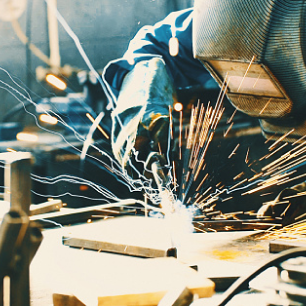Jump to:
So, You Want to be a CWI?
Are you currently considering a career as an AWS Certified Welding Inspector (CWI)? If so, I would like to take a moment to share with you some of my adventures and experiences as a CWI. It has been a challenging, exciting, and rewarding endeavor.
I struck my first arc at a New Jersey, family-owned fabrication shop in the late 1980s. At Cherefko & Son, we would inspect/repair tanker trucks for the fuel delivery industry. I would often find myself climbing around inside tanker trucks, performing visual weld inspection and weld repairs.
One day, the winds of change blew, propelling me south to the state of Virginia. Shortly after settling in, I took a weld test in hopes of getting a new job. The inspector giving the test asked if I had any weld inspection experience. I said, “Yeah, every week for the past 14 years.” He appeared intrigued and asked if I would like a job as a welding inspector, at which point I told him I would. We then made plans to meet at a hotel near Boston, Mass.
Upon arriving to the hotel, my new boss greeted me with a cup of coffee, a book on magnetic particle inspection, a horseshoe-type device with a power cord attached, and a plastic bottle. After two-and-a-half hours of indoctrination into the nondestructive examination (NDE) world, we headed out to the job site. My boss pointed to a crane parked next to a big hole in the ground and instructed me to be back here at 6:45 the next morning. The work was a tunnel project, an aqueduct for Boston.
The next morning, I climbed into a man cage with several other men, and a crane lowered us down a 350-ft-deep shaft to the 17-mile-long tunnel below. They unhooked the man cage and began hoisting materials. I found the weld team supervisor torch-cutting a chain link used to attach his welding machine to the steel tunnel wall liner where it had been secured. He asked me if I was the CWI there to inspect his work. I said, “I don’t know anything about a CWI, but I do have a magnet and some red powder.” He just shook his head.
After returning home, I spoke to my boss about the CWI question, and he informed me that he would like me to become an AWS CWI. Then, I enrolled in the week-long CWI seminar. I studied, but I was becoming nervous. So, I headed down to Chesapeake, Va., in the shadow of the Newport News Shipyard industry, and immersed myself in the week-long course. It was very informative and a huge help in preparing me for the test-taking experience. I passed all three portions of the test on my first try and have never looked back.
Not Your Typical Day at the Office
9/11
On a crisp fall morning, while working a pipeline outage at the University of Maryland in College Park, September 11, 2001, unfolded. I was waiting for the group of welders to complete their tasks so I could inspect. Unable to leave, I listened to the news reports on the radio. I climbed to the roof and was able to see the smoke rising from one of my other job sites, the Pentagon. We finished our tasks, and I headed for home. At 5:00 p.m., I got on Route 495, also known as the Beltway. The Beltway was completely empty and very surreal because it’s never empty. A few military vehicles raced about while I tried to call back home, but I struggled to connect. Finally, I reached Cherefko & Son, and my father answered. We were both relieved to hear each other’s voices. My father knew I was working at the Pentagon Wedge One renovation.
The previous week I had been at the Pentagon, exactly where the plane struck, but I had finished my inspections. The following week, I was requested back at the Pentagon to inspect some welded piping connections located deep underground. I showed up at the gate and was greeted by a soldier armed with an M16 rifle that was also fitted with a grenade launcher. “No book bags, no back packs, no lunch boxes!” he shouted. When I finally entered the work area, the smell of smoke still lingered. I noticed a strange shadow on the wall. It was hundreds of pieces of shattered tempered glass. It formed a silhouette of the windowpane that had been violently forced from the opposing wall by an explosion. On my desk, I still have a piece of charred limestone that I picked from the rubble.
Mission Impossible
One inspection job was like a scene from a movie. After inspecting the helicopter landing pad on the roof of a hospital located in Charlottesville, Va., I was asked to inspect a structural steel connection for the penthouse addition, which would be utilized to access the helicopter pad. To inspect the connection, we had to climb on top of the elevator car and take it to the top. The thyssenkrupp operator hacked the control panel, and with the wires hanging out, set the car in motion. “Hang on. Here we go!” It was dark, but light snuck in through small gaps that outlined the elevator doors at each floor as we rushed past. I leaned over and looked down the adjacent 80-ft-deep elevator shaft, and it was a long way down. After two clicks to tighten the hard hat so it wouldn’t blow off, I realized that an elevator ride feels a whole lot faster when you are on top of the car. When I got home that evening, my wife asked how my day went. I said, “Just another day as a CWI.”
On another job, I donned a double set of medical scrubs, was escorted into a clean room, and while suspended by my safety harness, I was slowly lowered by a hand-powered crane into a pharmaceutical manufacturer’s mixing tank.
Quantico
At another point, I showed up for my first day of work at the FBI Academy, located within the Quantico Marine Corps Base in Stafford County, Va. I was setting up my workstation in the corner of a job trailer when a loud explosion shook the trailer and everything in it. Startled, I ran outside. Looking around, I could see nothing that was destroyed. I then heard someone say, “First day on the job?” I looked over to an adjacent job trailer to see a guy taking a smoke break, leaning on the handrail, and answered him by saying yes. “The boys are just training; you will get used to it,” he said. There was nothing in my job description under the category of work environment that included flashbang grenades. This was one of my most interesting job sites to date.
AWS Seminar
Most recently, it was time to renew my CWI credential. For my second nine-year renewal, I elected to retake Part B. I again looked to AWS to guide me through their test-taking process and enrolled in the three-day seminar. Everything we covered in the study group, including the questions on the test, were all tasks I had experienced in the past 18 years as a CWI.
Conclusion
I have driven more than 1000 miles every week for a decade. I have worked up and down the east coast, from South Beach, Miami, Fla., to the tunnel project in Framingham, Mass. I have influenced engineers to rethink their design because they did not account for the lack of a welded connection at the bar joist seat when they switched to a nonballasted roof design.
Throughout my career, I have inspected powerhouse boilers, churches, gas pipelines, components for fighter jets, steam turbines, apparatuses for the nuclear powerhouse industry, bridges new and in service, water towers, schools, hospitals, museums, and various components for all branches of the armed services. I have been asked to inspect concrete, soils, mortars, fireproofing, post tension construction methods, painting for bridges, cranes, metal framed trusses, and pre-engineered metal buildings, all of which are extensions of my CWI career. I now work at a machine shop in Sandston, Va. We work with some of the biggest names in the industry.
Lastly, but most importantly, I met my beautiful wife on a jobsite. She thought CWIs were pretty cool.
BRETT J. CHEREFKO (b.cherefko@gmail.com) is an AWS CWI and a weld process specialist, Kosmo Machine, Sandston, VA.


